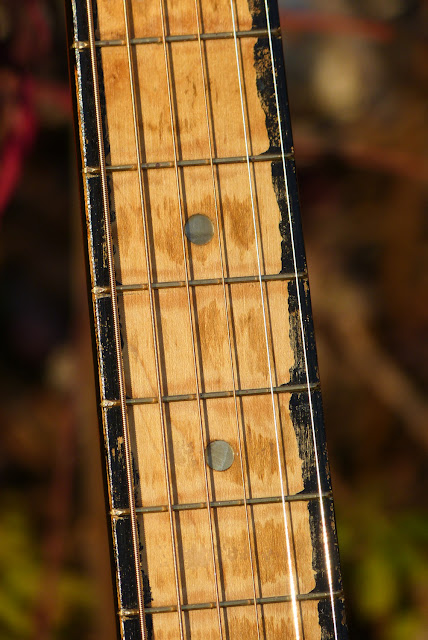1920s Oscar Smidt-made FHCM Parlor Guitar
Apparently, I worked on three of this same-type guitar last year, with one being a nice "twin" for it. These are popular guitars in the "funky old delta blues" market and, because they were made by Schmidt (of "Stella" fame), they simply sound great. Unlike a contemporaneous, same-market-point Harmony or Regal product of the time, these OS builds have a much woodier, folkier, warmer tone that really suits a harder attack -- especially with picks of various sorts.
Originally this guitar was made for the Hawaiian guitar market under the First Hawaiian Conservatory of Music brand -- meaning it was intended to be used with a steel/slide/bar and face-up in the lap with the strings raised. It even had its original (tall) nut and some of its original Hawaiian-tuning reference note stickers on the fretboard when it came to the shop. I converted it to a regular "Spanish" guitar and gave it a neck reset, fret level/dress, new rosewood (compensated) bridge, one crack cleat job just forward of the bridge, a new bone nut and saddle, and a good setup.
It's playing on-the-dot with 3/32" EA and 1/16" DGBE action at the 12th fret and strung with "lights" gauged 54w-12. The neck is straight in service, has a generous V/C mixed shape to it, and the saddle is nice and tall and with a drop-in slot for later adjustments.
This guitar is made from solid birch in the body with only one hairline crack (cleated) extending from above the bridge to the soundhole. The body is ladder-braced, but unlike a lot of Schmidts, only has 3 main braces -- one above the soundhole and two below. In-between the two below there's a fairly large section of soundboard-thick spruce glued to the underside of the soundboard like a big "bridge plate." This is found on all of the old FHCM-branded Schmidts I've worked on and is probably key to their sounding so good -- light bracing and a light build but with a stiffener/support in the top that keeps the soundboard from distorting too much.
The nut is a hair over 1 3/4" in width.
The maple fretboard is on top of a poplar neck. Schmidt usually covered these boards with stickers giving the notes for each fret when played in open A tuning, but most had fallen off of this guitar and so I removed the rest of the bits. When you do that, there's always a "stripe" of bleached wood in the center that was never "ebonized" and one usually finds a couple of position dots (as seen here in celluloid) hiding-out, too.
The binding at the top edge and soundhole is celluloid and, yes, that means it's real instead of painted-on.
My replacement rosewood pyramid bridge is a bit oversized compared to the original rectangular one, but it's a heck of a lot more practical and includes a compensated, drop-in saddle slot. The pearl-dotted wood pins are, by the way, original equipment!
The back shows some wear and a couple of areas with finish damage that's possibly heat- or moisture-induced. No worries, though, as the guitar has that usual "starting-to-alligator" old Schmidt finish look to it.
The tuners are original and work well, though one button is a replacement (the original split). I may replace one other, too, as I see a tiny hairline in it.
There's plenty of saddle on this one!




















Comments